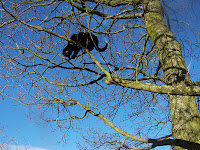Humans are anthropocentric in their views about domestication. For years and years they have believed in a myth - that we cats were domesticated by humans. Their general view was that humans went out into the desert, found some wild kittens of Felis silvestris Lybica, brought them home and then brought them up as companion animals about 4000 years ago to become Felis catus. This happened in Ancient Egypt when gods were worshipped in animal form including goddesses like the cat Bastet.
Now those in charge of the cat genome project, headed by Stephen O Brien, chief of the Laboratory of Genomic Diversity at the National Cancer Institute in Bethesda, Maryland, have had to accept that this isn't how it was. It all started much earlier. The scientist discovered five lineages of mitochondrial DNA in modern cats. Because of this variation, the researchers believe domestication occurred a half-dozen times or so in the Middle East.
According to the genome research the five female ancestors of Felis catus were Felis silvestris Lybica, African wild cats, mousing their way across the deserts some 130,000 years ago. So that settles our ancestry. But how did it happen? Five separate sets of adopted kittens? I think not. More likely five adventurous female Felis silvestris Lybica. The discovery of five different events of domestication suggests domestication was the other way round - or so I think. Cats moved into human life of their own accord.
The theory was that cats turned up in human settlements when man first started growing grain. But now we know that early man settled in one place before the advent of grain farming. And the cats moved in on him. Why? Not because grain brings mice but because human garbage (with or without grain) brings rats and mice. Rats are bigger and better prey. And also because humans offer dry shelter for us. Of course rats can be found among wandering human tribes that don't settle in one place. Celia has seen for herself the rats in a Beduin camp. But because we cats have a decent sense of territory (unlike dogs who started following human tribes much earlier) we don't move around much. Tents are dry shelter but they keep being taken down and set up in a new place. So we had to wait till man was civilised enough to settle in one spot.
Then we moved in. It was nothing to do with captured kittens (a ridiculous idea). We moved in and we began to overcome our disgust at Homo sapiens, a species which hitherto we had avoided at all costs. In order to benefit from their garbage rats and mice (and later more mice when they started grain growing) we had to put up with them. And their buildings gave us valuable warmth and shelter, so we moved a bit closer. Or at least those five desert cats did. And their descendants who could put up with the nearness of mankind flourished better than the descendants that simply couldn't bear being around this blundering species.
There's a posh word for it - commensality. We began living side by side, seperate but equal. (Well, not exactly equal. More like separate but essentially different in status, cats above and humans below.) Then we began to tame them so that they started behaving better to us. They threw us the occasional scrap of food as well as understanding our valuable contribution to the grain economy. We worked as natural pesticides and rodent control operatives. Their babies and children grew up near cats and became socialised to them. We also socialised them by sleeping close to them for warmth and amusing them with our antics.
Some cats have even put forward the theory that Homo sapiens (so called) started settling in one place because they looked at our behaviour and imitated it. First they learned about social hunting from dogs, because they followed the wolf packs and, like hyenas, shooed off the wolves and ate their prey. So they imitated their hunting methods, were successful, and some of the wolves started following them instead. But imitating dogs could only help with primitive hunting and social life. They needed more to become modern and civilised.
They saw that territoriality worked for cats and opted to follow in our paw prints. It makes sense to me. Having a proper home den and a hunting range helps with the safe bearing of kittens, whether cat or human. And this is a great deal more likely that nonsense about humans kidnapping kittens and taming them to their requirements. Everybody knows that, as Saki put it, "the cat is only domesticated as far as it suits his own ends." I would merely add humans are the most completely domesticated species on earth. They show much more of the juvenility of domestication than we do. (More on that later perhaps)
Our lineage dates back 130,000 years (beat that, Debretts!) and we domesticated humans.

.jpeg)



